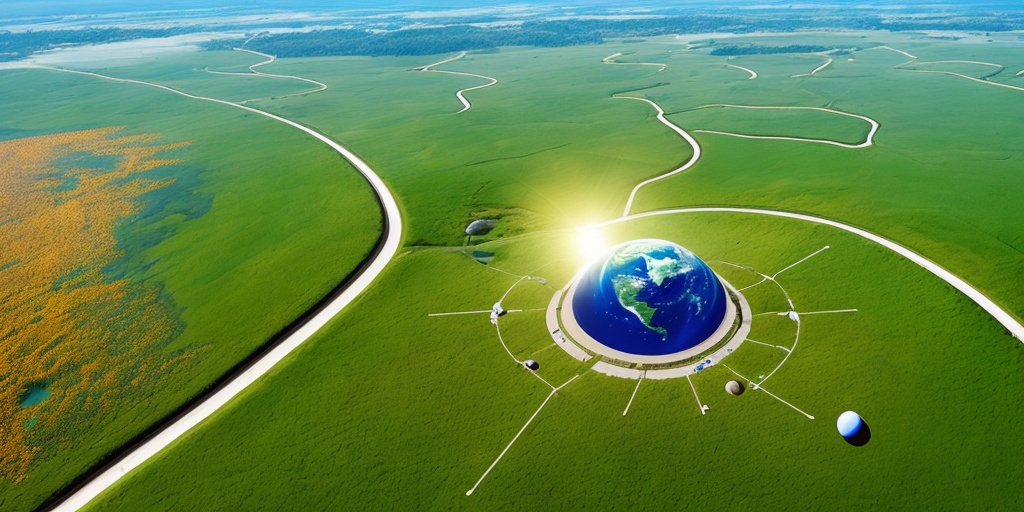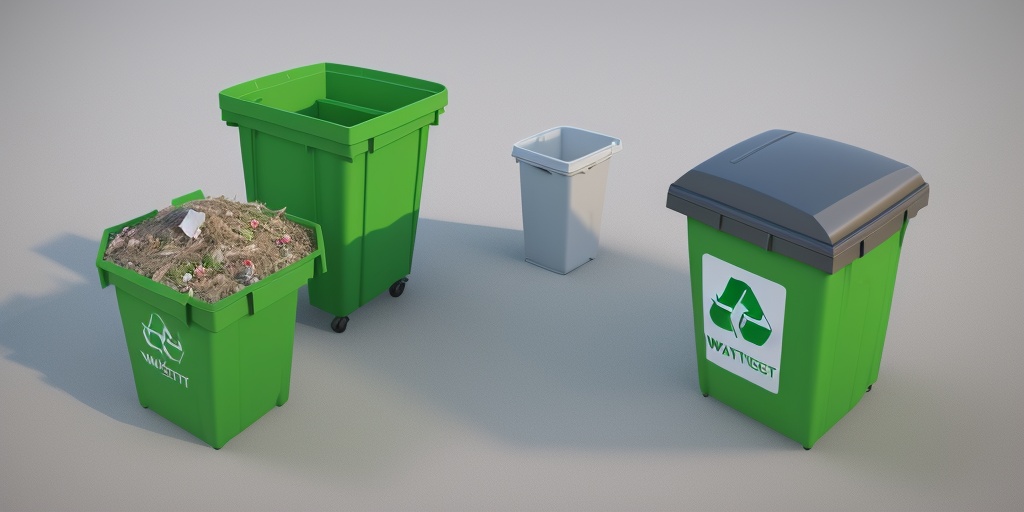We live in an era where our planet is under more pressure than ever before. Climate change, overpopulation, and the ever-increasing demand for resources have led to a need for innovative solutions to manage and conserve our precious resources. Enter artificial intelligence (AI), a powerful technology that’s quietly revolutionizing the way we approach sustainability.

The Power of Prediction
One of the most exciting aspects of AI is its ability to analyze vast amounts of data and make predictions based on patterns it identifies. In the realm of sustainability, this translates to more efficient and eco-friendly resource management.
Take, for example, our power grids. The integration of AI technology is already transforming how we manage energy production and distribution. By using machine learning algorithms, AI can predict and respond to fluctuations in energy demand, ensuring that power plants produce just the right amount of electricity at the right time. This not only helps to reduce energy waste but also enables smoother integration of renewable energy sources, such as solar and wind power, into the grid.
One of the most notable examples of AI-driven energy optimization is Google’s DeepMind. In 2016, the company revealed that its AI system had reduced the energy used for cooling its data centers by an impressive 40%. By analyzing data from various sensors and making real-time adjustments to the cooling systems, DeepMind was able to achieve unprecedented levels of energy efficiency.
But energy management is not the only area where AI’s predictive powers are making a difference. In the water industry, AI is being used to forecast demand and optimize water distribution systems. By analyzing data from various sources, such as weather forecasts, historical consumption patterns, and infrastructure conditions, AI can help water utilities minimize water loss, detect leaks, and reduce energy consumption in pumping stations.
Furthermore, AI is playing an increasingly significant role in transportation and urban planning. Cities around the world are using AI-powered traffic management systems to predict congestion patterns and optimize traffic flow, reducing both fuel consumption and emissions. In addition, AI is helping city planners design more sustainable urban environments by predicting the impact of various infrastructure projects on energy consumption, air quality, and other sustainability indicators.
As we look to the future, the power of AI’s predictive capabilities will undoubtedly continue to grow, unlocking new possibilities for eco-friendly resource management. By harnessing the power of AI, we can pave the way towards a more sustainable and efficient world, where our limited resources are used wisely and to their fullest potential. And while there will always be challenges to overcome, the promise of AI in driving responsible resource management and conservation is too great to ignore.

Agriculture Gets a Boost
Farmers have always faced the daunting task of managing limited resources to feed a growing population, all while dealing with unpredictable weather patterns and rapidly changing market conditions. However, the advent of AI-driven precision farming is revolutionizing the agricultural landscape, providing farmers with the tools they need to optimize the use of water, fertilizers, and pesticides, and ultimately, achieve more sustainable and efficient farming practices.
By harnessing the power of AI, precision farming combines data from soil sensors, satellite imagery, and weather forecasts to make informed decisions about when and where to plant, irrigate, and apply fertilizers and pesticides. This data-driven approach enables farmers to maximize crop yields while minimizing their environmental footprint, preserving precious resources for future generations.
Take, for example, the use of AI in optimizing irrigation systems. In the past, farmers often relied on intuition and experience to determine when and how much water to apply to their fields. But with AI-powered irrigation systems, farmers can now use data from soil moisture sensors and weather forecasts to determine the precise amount of water needed for each individual crop. This not only helps to conserve water but also ensures that crops receive the optimal amount of moisture, resulting in higher yields and improved crop quality.
Another area where AI is making a significant impact is in pest and disease management. Traditionally, farmers have had to rely on blanket applications of pesticides to protect their crops, often resulting in overuse and negative environmental consequences. However, AI-driven systems are now able to analyze data from drones and satellite imagery to identify areas of pest infestation or disease outbreak, allowing farmers to target their pesticide applications more precisely. This targeted approach not only reduces the overall use of pesticides but also helps to mitigate the risk of pesticide resistance.
Moreover, AI is playing a vital role in crop selection and planting strategies. By analyzing historical data and current market trends, AI systems can help farmers determine the most profitable crops to plant and the optimal time to plant them, ensuring the best possible return on their investment.
The benefits of AI-driven precision farming extend beyond the individual farmer. By improving resource management and reducing waste, these technologies have the potential to enhance global food security and combat climate change. As the world’s population continues to grow, and our natural resources become increasingly strained, AI has the potential to be a game-changer in the agricultural industry, helping to ensure a sustainable future for generations to come.

Waste Not, Want Not
One of the most significant challenges facing the world today is the efficient and environmentally friendly management of waste. With growing populations and increasing levels of consumption, the strain on our landfills and recycling centers has reached a critical point. Fortunately, AI is providing innovative solutions to help tackle this pressing issue, revolutionizing the way we recycle and manage waste.
AI-powered robots equipped with computer vision and machine learning capabilities are now being deployed to quickly and accurately sort recyclable materials. These advanced systems can differentiate between various types of plastics, metals, and paper products, ensuring that each material is properly sorted and directed to the appropriate recycling facility. This not only increases the efficiency of recycling centers but also helps to reduce the amount of waste that ends up in our landfills, cutting down on greenhouse gas emissions and other environmental pollutants.
Moreover, AI is playing a crucial role in tracking waste generation patterns and informing more sustainable waste management strategies. By collecting and analyzing data on waste generation, disposal, and recycling rates, AI systems can help businesses, municipalities, and policymakers identify areas for improvement and develop targeted interventions to reduce waste. This could include designing more efficient packaging materials, implementing public education campaigns on recycling, or even enacting new regulations to encourage waste reduction.
In addition, AI-driven waste management systems have the potential to facilitate a more circular economy by promoting the reuse and repurposing of materials. As AI-powered robots become more adept at identifying and sorting recyclable materials, they can also help to identify new uses for previously discarded items. This, in turn, can lead to the development of innovative new products and materials, helping to reduce our dependence on non-renewable resources and create a more sustainable future.
The power of AI in waste management extends beyond recycling centers and landfills. By enabling smarter, more efficient, and more sustainable waste management strategies, AI has the potential to transform the way we consume and dispose of goods, creating a cleaner and greener world for all.
In the ongoing battle to preserve our planet and its resources, the combination of AI and sustainable waste management practices is proving to be a powerful ally. As technology continues to advance, and as AI becomes more integrated into our daily lives, the potential for even greater strides in waste reduction and resource conservation is limitless. It’s clear that, when it comes to waste management, AI is helping to ensure that we truly waste not, want not.

Protecting Our Natural Resources
The ability of AI to manage resources more effectively is only one part of the sustainability equation. Equally important is its role in safeguarding our planet’s precious natural resources. Through monitoring activities like deforestation, illegal fishing, and poaching, AI is playing a critical role in helping conservationists and law enforcement agencies identify and prevent further damage to our ecosystems.
Advanced satellite imagery and machine learning algorithms can now detect and track signs of illegal activities in real-time, such as logging in protected forests or unauthorized fishing vessels in restricted marine zones. By promptly alerting the relevant authorities, these AI-driven systems enable swift intervention, minimizing the impact on the environment and its inhabitants.
Furthermore, AI-driven predictive models are proving invaluable for prioritizing the most effective strategies for restoring affected areas. By analyzing historical data and identifying trends, these models can help guide conservation efforts and allocate resources more efficiently. This targeted approach allows for the implementation of restoration projects that have the greatest potential for long-term success and ecological recovery.
AI is also playing a role in the fight against climate change by monitoring and predicting the effects of rising temperatures on ecosystems, helping to inform mitigation and adaptation strategies. For example, AI models can predict the impact of rising sea levels on coastal communities, allowing for the development of early warning systems and infrastructure improvements to minimize damage.
In the fight to preserve our natural resources, AI is proving to be a formidable ally. By enabling the early detection and prevention of environmental threats, AI is giving conservationists and policymakers the tools they need to make informed decisions and implement effective strategies. As AI continues to advance and integrate into our efforts to protect and restore our planet, the potential for even greater strides in environmental conservation becomes increasingly apparent. In the race against time to safeguard our natural resources, AI is proving to be a powerful force for good.
The Challenges Ahead
While AI offers immense potential for driving sustainability and promoting eco-friendly practices, it is not without its challenges. To harness the full power of AI, we must confront and address several pressing issues, such as data privacy, algorithmic biases, and the need for standardized guidelines.
Data privacy is a significant concern in the age of AI, as the technology relies on vast amounts of data to function effectively. The collection, storage, and use of this data must be carefully managed to protect the privacy of individuals and prevent the misuse of sensitive information. Ensuring robust data protection measures and transparent data management practices are in place will be crucial for building public trust in AI applications.
Algorithmic biases pose another challenge. AI systems are only as unbiased as the data they are trained on, and any biases present in the training data can be perpetuated in the AI’s decision-making processes. This can have significant consequences, especially in areas like resource allocation and conservation efforts. To mitigate this issue, we must strive for diverse and representative data sets and develop methods for detecting and correcting biases in AI algorithms.
The need for standardized guidelines is also critical. As AI technologies become increasingly integrated into various industries and aspects of society, the development of clear ethical and regulatory frameworks becomes essential. These guidelines should address issues such as transparency, fairness, and accountability in AI applications, ensuring that the technology is developed and deployed responsibly and for the greater good.
Despite these challenges, AI continues to evolve and holds great promise in our quest for a more sustainable and eco-friendly future. By tackling these issues head-on and fostering a culture of collaboration and innovation, we can ensure that AI becomes an indispensable tool in our efforts to protect and preserve our planet for generations to come.
The bottom line is this: AI has the power to reshape the way we manage and conserve resources, ensuring that our planet remains habitable for generations to come. It’s an exciting prospect, and one that has the potential to change the game in our battle for sustainability.



